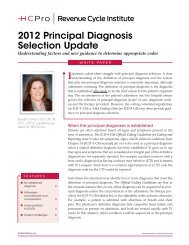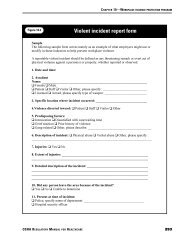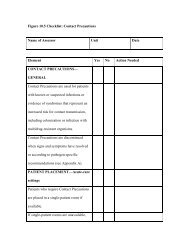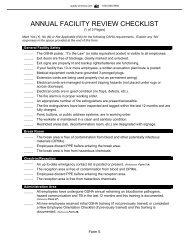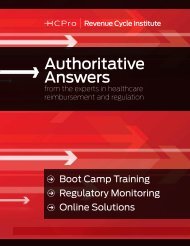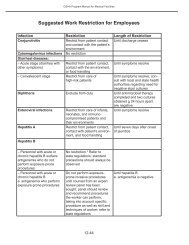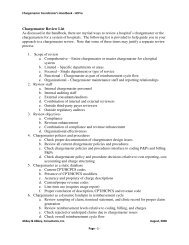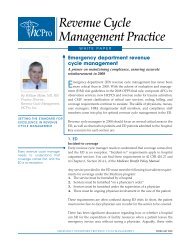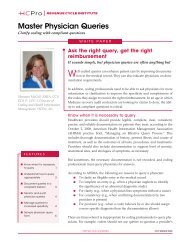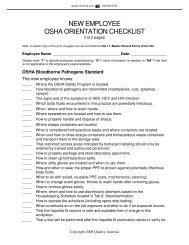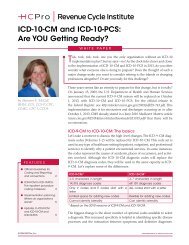Sepsis and Septicemia: Clear Up Coding and ... - HCPro Blogs
Sepsis and Septicemia: Clear Up Coding and ... - HCPro Blogs
Sepsis and Septicemia: Clear Up Coding and ... - HCPro Blogs
Create successful ePaper yourself
Turn your PDF publications into a flip-book with our unique Google optimized e-Paper software.
4 Present on Admission: Accurate reporting to ensure appropriate reimbursement October 2009<br />
<strong>Coding</strong> for SIRS, sepsis, <strong>and</strong> severe sepsis requires a minimum of two codes:<br />
A code for the underlying cause (such as infection or trauma) <strong>and</strong> a code<br />
from subcategory 995.9 (SIRS).<br />
The ICD-9 Manual tabular index states that coders should report the additional<br />
code 995.9 to identify SIRS, <strong>and</strong> the chapter-specific official coding<br />
guidelines further state that the physician must have documented either<br />
sepsis or SIRS to report the code. When the physician documentation merely<br />
states septicemia is present, it is inappropriate to report a code from subcategory<br />
995.9x without querying the physician.<br />
Coders can reflect the source of the infection by the use of codes within the<br />
995.9x subcategory when appropriate. Coders should report codes 995.91<br />
or 995.92 as an additional code to identify SIRS due to infectious process,<br />
depending on whether there is organ failure/dysfunction. Codes 995.93 <strong>and</strong><br />
995.94 are used to report SIRS due to noninfectious process (e.g., trauma,<br />
burns). Again, the decision regarding which of the two to report depends on<br />
the presence of organ failure or dysfunction. E codes are unnecessary with<br />
codes 995.91 <strong>and</strong> 995.92.<br />
Septic shock cannot occur<br />
in the absence of severe<br />
sepsis.<br />
If a patient admits for a localized infection <strong>and</strong> the sepsis, severe sepsis, or<br />
SIRS develops after admission, the localized infection would be the principal<br />
diagnosis with an additional code for sepsis, severe sepsis, <strong>and</strong> SIRS.<br />
When a physician documents septic shock, coders should report the systemic<br />
initiating infection first, then either code 995.92 or 995.94 <strong>and</strong> then<br />
785.52 for the septic shock. Coders must report the code from subcategory<br />
995.9x before the code for septic shock. Septic shock cannot occur in the<br />
absence of severe sepsis.<br />
For patients with severe sepsis with organ dysfunction or failure, coders<br />
must also remember to identify the specific organ dysfunction or failure (e.g.,<br />
renal or respiratory failure).<br />
Other code options to note include the following:<br />
■■<br />
Code 790.7 for bacteremia that is not further defined<br />
■■<br />
Code 799.89 for toxemia that is not further defined<br />
■■<br />
Code 599.0 for urosepsis that is not further defined<br />
■■<br />
Code 996.62 for line sepsis that is not further defined<br />
■■<br />
Code 771.81 for newborn sepsis<br />
Urosepsis is a nonspecific term. If it is the only term documented, coders<br />
should report code 599.0 based on the default for the term in the ICD-9<br />
Manual index. In addition, coders may report the code for the causal organism<br />
if known, according to the <strong>Coding</strong> Clinic, Volume 24, Number 4, fourth<br />
quarter 2007. Note also that a medical executive committee may not legislate<br />
that urosepsis means sepsis as a substitute for physician documentation per<br />
© 2009 by <strong>HCPro</strong>, Inc. Any reproduction is strictly prohibited. For more information, call 877/233-8734 or visit www.revenuecycleinstitute.com.



